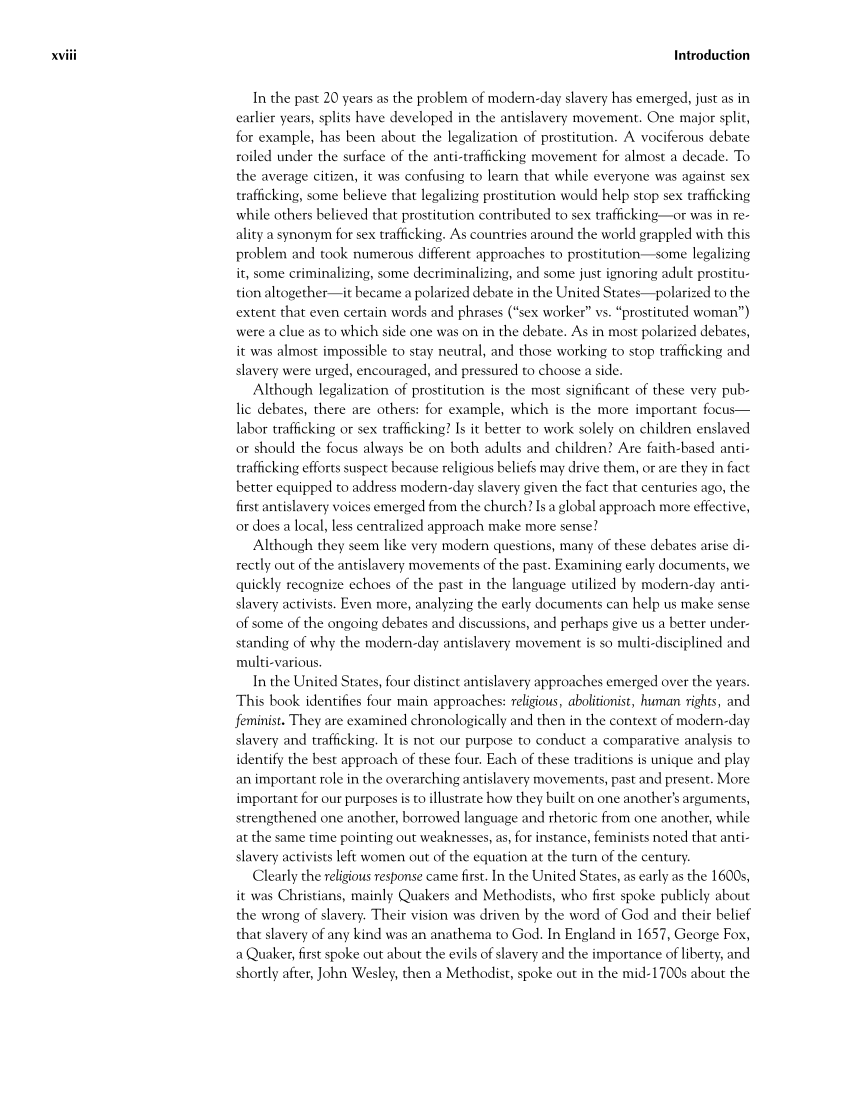xviii Introduction In the past 20 years as the problem of modern-day slavery has emerged, just as in earlier years, splits have developed in the antislavery movement. One major split, for example, has been about the legalization of prostitution. A vociferous debate roiled under the surface of the anti-traffi cking movement for almost a decade. To the average citizen, it was confusing to learn that while everyone was against sex traffi cking, some believe that legalizing prostitution would help stop sex traffi cking while others believed that prostitution contributed to sex traffi cking—or was in re- ality a synonym for sex traffi cking. As countries around the world grappled with this problem and took numerous different approaches to prostitution—some legalizing it, some criminalizing, some decriminalizing, and some just ignoring adult prostitu- tion altogether—it became a polarized debate in the United States—polarized to the extent that even certain words and phrases (“sex worker” vs. “prostituted woman”) were a clue as to which side one was on in the debate. As in most polarized debates, it was almost impossible to stay neutral, and those working to stop traffi cking and slavery were urged, encouraged, and pressured to choose a side. Although legalization of prostitution is the most signifi cant of these very pub- lic debates, there are others: for example, which is the more important focus— labor traffi cking or sex traffi cking? Is it better to work solely on children enslaved or should the focus always be on both adults and children? Are faith-based anti- traffi cking efforts suspect because religious beliefs may drive them, or are they in fact better equipped to address modern-day slavery given the fact that centuries ago, the fi rst antislavery voices emerged from the church? Is a global approach more effective, or does a local, less centralized approach make more sense? Although they seem like very modern questions, many of these debates arise di- rectly out of the antislavery movements of the past. Examining early documents, we quickly recognize echoes of the past in the language utilized by modern-day anti- slavery activists. Even more, analyzing the early documents can help us make sense of some of the ongoing debates and discussions, and perhaps give us a better under- standing of why the modern-day antislavery movement is so multi-disciplined and multi-various. In the United States, four distinct antislavery approaches emerged over the years. This book identifi es four main approaches: religious, abolitionist, human rights, and feminist . They are examined chronologically and then in the context of modern-day slavery and traffi cking. It is not our purpose to conduct a comparative analysis to identify the best approach of these four. Each of these traditions is unique and play an important role in the overarching antislavery movements, past and present. More important for our purposes is to illustrate how they built on one another’s arguments, strengthened one another, borrowed language and rhetoric from one another, while at the same time pointing out weaknesses, as, for instance, feminists noted that anti- slavery activists left women out of the equation at the turn of the century. Clearly the religious response came fi rst. In the United States, as early as the 1600s, it was Christians, mainly Quakers and Methodists, who fi rst spoke publicly about the wrong of slavery. Their vision was driven by the word of God and their belief that slavery of any kind was an anathema to God. In England in 1657, George Fox, a Quaker, fi rst spoke out about the evils of slavery and the importance of liberty, and shortly after, John Wesley, then a Methodist, spoke out in the mid-1700s about the
Document Details My Account Print multiple pages
Print
You have printed 0 times in the last 24 hours.
Your print count will reset on at .
You may print 0 more time(s) before then.
You may print a maximum of 0 pages at a time.





































































































































































































































































































































































































